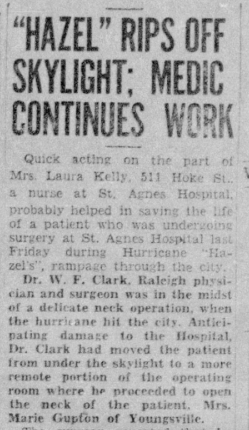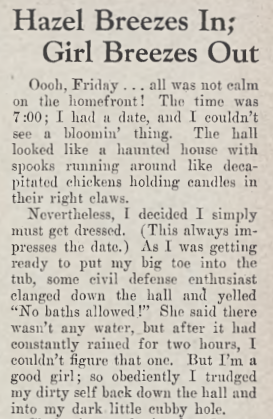
Hurricane Hazel damage, 1954.
Blog post contributed by Allison Hall, Special Collections Graduate Assistant.
We’re back with another Weather PastCast! We’re returning to the United States Weather Bureau, Raleigh Office Records to discuss one of the most catastrophic weather events in North Carolina history, Hurricane Hazel.
One of the most notorious weather catastrophes in Raleigh’s history is Hurricane Hazel, which tore through the North Carolina in mid-October 1954. The hurricane culminated from a season of unusually hot weather. In the summer of 1954, the city of Raleigh experienced a prolonged heat wave. Starting around June 22 and lasting until September 9, temperatures across North Carolina rose into the 100s. On June 27, 1954, the temperature in Raleigh reached a high of 104 degrees. The weather records for the summer of 1954 demonstrate that this extreme heat was punctuated by periods of comparatively cooler weather. On September 6, the temperature again reached 104 degrees.

A note on the monthly weather summaries for September 1954 states that, “the maximum temperature of 104 degrees registered on the 6th sets a new high record for the month of September in Raleigh. Daily high records were also broken on the 5th and 7th. The rainfall total of 0.57 inch is the lowest September precipitation since 1922.”

Temperature records were also broken in October 1954, with highs in the 90s during the first 6 days of the month. Hot weather continued in the middle of the month, ending with the passage of Hurricane Hazel through North Carolina on October 14-15, 1954.
Preceded by a summer heat wave, drought, and unseasonably hot fall temperatures, Hurricane Hazel passed through the Raleigh area, dumping 4.10 inches of rain on the city on October 14 and 15. The “notes” section of the October 15 report contains an “Excessive Precipitation” stamp used to track rainfall at short intervals. The highest sustained wind velocity in Raleigh during the hurricane was 62 miles per hour, with higher gusts sustained in nearby areas. Hazel killed 19 people in North Carolina, and injured hundreds; thousands of homes were damaged and destroyed as the storm made its way north through the state.

In the 1955 Agromeck, NC State students recognized Hurricane Hazel as a key event in the United States during the 1954-1955 school year, acknowledging the hurricane’s impact by including photographs of storm damage in West Virginia and Ohio. The yearbook did not address damage in North Carolina, instead framing the hurricane as a national event.

Similarly, an article in the Technician from October 21, 1954, noted that the hurricane’s impact on campus was limited to some tree and minor building damage. The storm blew the cupola off of Berry Hall (misidentified as Becton in the Technician article), which was not restored until 2006, and damaged the press box in the football stadium. Communication with coastal North Carolina was cut off during the storm, and the Governor of North Carolina, William B. Umstead, relied on the university’s Amateur Radio Club to maintain connection to the coast while the storm raged.
![Technician, Vol. 39 No. 7 [Vol. 35 No. 7], October 21, 1954](/sites/default/files/inline-images/image5.png)
Additionally, local newspapers published stories and pieces of creative writing about the hurricane. On October 23, 1954, The Carolinian relayed a dramatic tale about a surgery that continued through the storm, despite a gaping hole in the ceiling, a lack of electricity, and ankle-deep flooding due to rain and a sprinkler system. The newspaper article also noted that the patient undergoing surgery had no idea that any of this happened until she awoke from anesthesia! The Belles of St. Mary’s, a student newspaper at St. Mary’s in Raleigh, included a vignette about a young woman’s difficulty preparing for a date during the storm’s power outage.


In this edition of PastCast, we’ve explored how Hurricane Hazel ripped through North Carolina. Interested in learning more about weather events in Raleigh’s history? Stay tuned for our next post in the PastCast blog series, or read previous posts in the series!
If you have any questions or are interested in viewing Special Collections materials, please contact us at library_specialcollections@ncsu.edu or submit a request online. The Special Collections Research Center is open by appointment only. Appointments are available Monday–Friday, 9am–6pm and Saturday, 1pm–5pm. Requests for a Saturday appointment must be received no later than Tuesday of the same week.